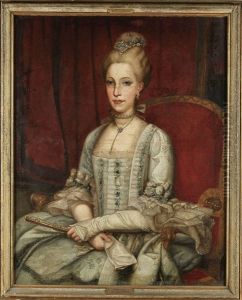Maria Cristina De Borbon Paintings
Maria Cristina de Bourbon, also known as Maria Cristina of the Two Sicilies, was not an artist in the traditional sense but rather a significant historical figure. She was born on April 27, 1806, in Palermo, Sicily, into the royal family of Bourbon-Two Sicilies. As the daughter of King Francis I of the Two Sicilies and his second wife, Maria Isabella of Spain, Maria Cristina was born into a life of privilege and political importance.
Maria Cristina's most notable role was as queen consort of Spain through her marriage to King Ferdinand VII of Spain. The union was strategic, intended to strengthen ties between the Spanish and the Neapolitan-Sicilian branches of the Bourbon family. She married Ferdinand VII on December 11, 1829, and her influence grew after she became his fourth wife. Maria Cristina was known for her intelligence and political acumen, which she exercised during her time as queen consort and regent.
After the death of Ferdinand VII in 1833, Maria Cristina became the regent for her daughter, Isabella II, who was only three years old at the time. Her regency was marked by political turmoil and the outbreak of the First Carlist War, a conflict rooted in a dispute over the Spanish succession. Maria Cristina, a supporter of liberal policies, faced opposition from the Carlists, who supported the king's brother, Carlos, as the legitimate heir to the throne.
Through her regency, Maria Cristina played a crucial role in the establishment of a constitutional monarchy in Spain and the eventual ascension of her daughter to the throne. Her efforts to modernize Spain and align it with liberal European movements, however, met with resistance and civil strife. She proved to be a polarizing figure, and her period in power was characterized by significant challenges, including the need to maintain the support of the liberals while managing the conflicts that arose from conservative factions.
Maria Cristina eventually abdicated her regency in 1840 but continued to exert influence behind the scenes. She spent her later years in exile in France, where she continued to be involved in Spanish politics. She passed away on August 22, 1878, in Le Havre, France. Her life has been the subject of historical study, and she is remembered as a key figure in the political and social transformations of 19th-century Spain.

